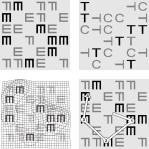Attention: The Selection Problem
 The solution to the binding problem (discussed yesterday) contains a second, related problem: at what point in the pattern recognition process, and hence on what kinds of representations, does attention operate? This is also known as the "space-based" versus "object-based" attention debate (covered previously by Cognitive Daily).
The solution to the binding problem (discussed yesterday) contains a second, related problem: at what point in the pattern recognition process, and hence on what kinds of representations, does attention operate? This is also known as the "space-based" versus "object-based" attention debate (covered previously by Cognitive Daily). Posner’s early spatial cueing experiments encouraged the view that attention selects stimuli on the basis of spatial location. The importance of spatial location to attention is also supported by evidence for enhanced stimulus processing in the vicinity of attended targets (Connor, et al., 1997, cited by Kanwisher & Wojciulik, 2000). Certainly, spatial information is important both for pattern recognition and attention.
One might claim that “pop out” phenomena indicate that attention can be guided by specific features, perhaps as identified in a pattern-recognition preprocessing subsystem, (Kosslyn, 1990). This conclusion is essentially correct, although it is complicated by unusual task-dependencies; for example, reaction time is not related to set size in the detection of the letter T from a display of L’s, but if each letter in the display is randomly reoriented, the “pop out” effect disappears. Based on a detailed analysis of this and other evidence, Wolfe & Horowitz (2004) identified a short list of features that are “undoubtedly” sufficient for the guidance of attention. They concluded that attention is also guided by at least some features.
Finally, persuasive evidence indicates that attention can be object-based, even in cases where the objects are superimposed (Kanwisher & Wojciulik, 2000) or occluded by other objects (Wolfe & Horowitz, 2004). Interestingly, while perceptual load increases target selection efficiency in object-based attention, the opposite relationship exists between cognitive load and target selection (Yi, et al., 2004, and De Fockert, et al., 2001, respectively, cited by Lavie, 2005). One might speculate that high perceptual load increases the efficiency of target object selection by more fully tapping the competition among “preattentive” representations, whereas high cognitive load may attentuate the top-down biasing of relevant features, and hence cause increased distractor object processing.
In summary, attention both influences and is influenced by the entire pattern recognition process, from low-level spatial information all the way up to integrated object representations. Attention can play two seemingly incongruous roles: it both groups patterns into unitary objects, and is able to select among those objects.
This stance is consistent with Duncan’s (2005) definition of attention as a “ubiquitous, temporally extended” competition between representations, in which more currently-relevant representations are more strongly amplified. In addition, any bottom-up representation with high TD differences also strongly influences the deployment of attention. This dual perspective firmly situates attention at the end of a two-way street, in which it can both flexibly bias pattern recognition processes in a top-down fashion, and yet can also be strongly influenced by bottom-up representations.
Related Posts:
The Binding Problem
Selection Efficiency and Inhibition
References:
Duncan, J. (2005). EPS Mid-Career Award 2004: Brain mechanisms of attention. THE QUARTERLY JOURNAL OF EXPERIMENTAL PSYCHOLOGY. 2006, 59 (1), 2–27
Kanwisher N, Wojciulik E.(2000) Visual attention: insights from brain imaging. Nat Rev Neurosci. 2000 Nov;1(2):91-100.Kosslyn SM, Flynn RA, Amsterdam JB, Wang G. Components of high-level vision: a cognitive neuroscience analysis and accounts of neurological syndromes. Cognition. 1990 Mar;34(3):203-77.
Lavie, N. (2005) Distracted and confused?: selective attention under load. Trends in Cognitive Sciences, 9, 75-82
Wolfe, JM & Horowitz TS. (2004). What attributes guide the deployment of visual attention and how do they do it? Nature Reviews Neuroscience, Jun;5(6):495-501


4 Comments:
Hi Chris- just popping on over to say thanks for posting over on Retro. You blog is very interesting, nice to get a more coggy approach (i'm pretty strict molecular/systems). I look forward to stopping by sometimes. Added you to my blogroll.....Cheers!
Hi Shelley - thanks for stopping in :) I'll add you to my blog list too.
wonderful blog.
thanks mang!
Post a Comment
<< Home